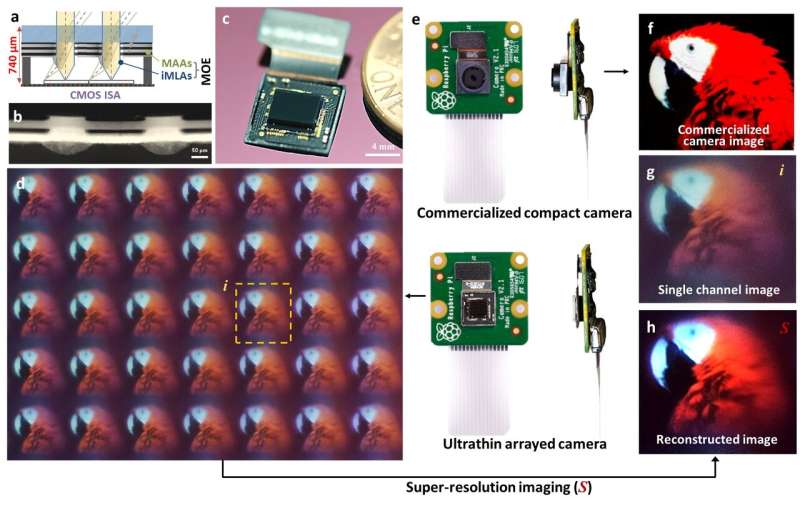a, Schematic illustrations of a biologically inspired ultrathin arrayed camera. The biologically inspired ultrathin camera features inverted microlens arrays (iMLA), multilayered aperture arrays (MAAs), gap spacers, and CMOS image sensor arrays (CMOS ISA). b, A cross-sectional optical image of iMLAs and MAAs. c, The captured array images of a red parrot. e, Photographs of a commercialized compact camera (upper) and the ultrathin arrayed camera (lower) to compare image performance with a comparable f-number lens. A red parrot image acquired by f. the commercialized camera and g. the single channel of the ultrathin arrayed camera. h. Reconstructed image from several channels. Credit: by Kisoo Kim, Kyung-Won Jang, Jae-Kwan Ryu and Ki-Hun Jeong
Vision systems in nature provide intriguing optical design inspiration for ultracompact imaging systems. Scientists in South Korea have now demonstrated a fully packaged ultrathin insect-eye camera, which offers high contrast and super-resolution imaging by using new optical materials and techniques. This ultrathin arrayed camera could have practical use in mobile devices, advanced surveillance vehicles, and endoscopes without technical reservation.
An insect's compound eye has superior visual characteristics such as wide viewing angle, high motion sensitivity, and large depth of field while maintaining a small volume of visual structure with a small focal length. Among them, Xenos peckii, an endoparasite of paper wasps, has eyes with hundreds of photoreceptors in a single lens—unlike conventional compound eyes with a few light-sensing cells in an individual eyelet. This unique structure offers higher visual resolution than other insect eyes. The Xenos peckii eye also perceives partial images through pigmented cups that block incoming light between eyelets.
Inspired from Xenos peckii eye structure, a KAIST research team led by Professor Jeong Ki-Hun demonstrated a fully packaged ultrathin insect eye camera. They developed a unique and new configuration of micro-optical elements to completely suppress the optical noise between microlenses while reducing camera thickness. This optical component was integrated with a complementary metal oxide semiconductor (CMOS) image sensor and the final thickness of the fully packaged camera lens is only 740 μm.
The fully packaged ultrathin arrayed camera has successfully demonstrated high contrast clear array images acquired from tiny microlenses. To further enhance image quality of the captured image, they have discussed the vision principle of insect eyes and combined the array images into one image through super-resolution imaging. This work also shows the first demonstration of super-resolution imaging, which acquires a single integrated image with high contrast and high resolving power reconstructed from high contrast array images.
"This work reports the first demonstration of an ultrathin arrayed camera for high contrast and super resolution imaging. We strongly believe our study will make technical advances and also have significant impacts on multidisciplinary communities of micro- and nanotechnology, mining insight from natural photonic structures," said Jeong.
More information: Kisoo Kim et al, Biologically inspired ultrathin arrayed camera for high-contrast and high-resolution imaging, Light: Science & Applications (2020). DOI: 10.1038/s41377-020-0261-8
Journal information: Light: Science & Applications
Provided by Chinese Academy of Sciences
























